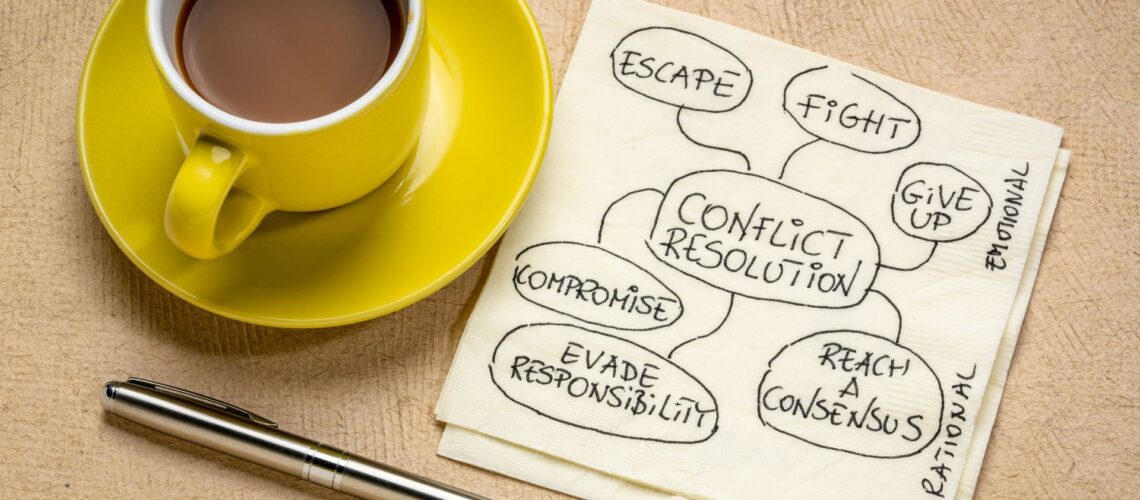In today’s fast-paced, high-stakes pharma and technical business environment, the ability to master leadership conflict resolution isn’t just a nice-to-have – it’s a defining trait of exceptional leaders. High-performing teams thrive not because they avoid conflict but because their leaders know how to navigate it with emotional intelligence, clarity, and confidence.
The Cost of Poor Conflict Management
According to a study by the University of Warwick and Acas1 Uk organisations experience a loss of around £28.5 billion a year due to workplace conflict.
This is because left unresolved, workplace conflict can lead to fractured teams, decreased productivity, and employee disengagement. Great leaders recognise that conflict resolution in theworkplace is not about avoiding disagreements but managing them constructively to drive innovation and alignment.
The Mindset of a Conflict-Resilient Leader
Leaders who excel at leadership conflict resolution embody a growth mindset. They don’t see conflict as a threat but as an opportunity for team development and deeper trust. This requires:
- Self-awareness: Knowing your triggers and staying composed under pressure.
- Empathy: Understanding diverse perspectives without immediately reacting.
- Courage: Addressing tension head-on with honesty and care.
These mindset qualities are rooted in emotional intelligence, which plays a central role in conflict resolution in the workplace.
Emotional Intelligence: The Foundation of Resolution
Daniel Goleman’s work on emotional intelligence highlights self-regulation, social skills, and empathy as key attributes. According to a study published in the International Journal of Research2 leaders with high EQ create psychological safety, encouraging team members to voice concerns without fear. This is critical when learning how to deal with conflict resolution in theworkplace in a way that maintains morale and momentum.
Core Skills That Set Great Leaders Apart
Active Listening
Truly hearing what is said (and unsaid) is the first step to effective conflict resolution in the workplace.
Clear Communication
Articulate issues without blame. Use “I” statements and keep the conversation future-focused.
Mediation and Facilitation
Skilled leaders know how to handle conflict resolution in the workplace by facilitating discussions where all voices are heard.
Decision-Making Under Pressure
When stakes are high, they remain calm and seek fair outcomes aligned with business objectives.
Feedback Loops
Feedback isn’t a one-off. Great leaders build a culture where feedback is continuous and constructive – a proactive approach to conflict resolution in the workplace.
Take a look at our Building High Performing Teams programme, for more information on how to develop strong leadership skills to help overcome conflict in the workplace.
Integrating the Thomas-Kilmann Conflict Resolution Strategies
The Thomas-Kilmann Conflict Model3 outlines five strategies for resolving workplace conflicts, each varying in assertiveness and cooperativeness:
- Avoiding: Best suited for situations where both the relationship and the goal are of low importance. While rarely ideal in the workplace, it can be appropriate when the issue is trivial or when more pressing matters take precedence.
- Competing: A high-assertiveness, low-cooperativeness approach, useful when quick, decisive action is needed, such as in emergencies. However, overuse can damage relationships.
- Accommodating: Low in assertiveness but high in cooperativeness, this strategy involves yielding to others’ needs. It’s effective when preserving harmony is more important than achieving personal goals.
- Compromising: A middle-ground approach where each party gives up something to reach a mutually acceptable solution. Useful when time constraints exist or when a temporary solution is needed.
- Collaborating: High in both assertiveness and cooperativeness, this strategy seeks a win-win solution by addressing all parties’ concerns. Ideal for complex issues where the relationship and the outcome are both important.
Understanding and applying these strategies allows leaders to tailor their approach to the specific context of each conflict, enhancing their effectiveness in conflict resolution in the workplace.
How to Deal with Conflict Resolution in the Workplace Proactively
To lead proactively means addressing tension before it escalates. Here are steps that show you how to deal with conflict resolution in the workplace effectively:
- Encourage open communication through regular one-to-ones.
- Set clear expectations about team values and behaviours.
- Train your team in active listening and feedback techniques.
- Regularly check the emotional pulse of your team.
When leaders model this approach, others follow, creating a culture where conflict resolution in the workplace becomes part of the team’s DNA. Explore how Coaching for Success can improve your ability to guide team discussions and manage disagreements.
How to Handle Conflict Resolution in the Workplace with Confidence
Confidence in conflict doesn’t come from always knowing the answer. It comes from trusting the process and your values. Here are key elements that help you build this confidence:
- Stay present and calm during tense conversations.
- Validate feelings without agreeing to unproductive behaviours.
- Use structured frameworks like “Describe, Express, Specify, Consequences” (DESC) for difficult discussions.
When you know how to handle conflict resolution in the workplace with intention, your leadership presence becomes a steadying force.

Frequently Asked Questions About Conflict Resolution in the Workplace
Conflict resolution in the workplace is the process of addressing and managing disagreements between individuals or teams. It’s crucial because unresolved conflict can lead to low morale, reduced productivity, and poor team cohesion. Effective conflict resolution promotes trust, collaboration, and innovation.
Leaders can handle workplace conflict confidently by developing emotional intelligence, staying calm under pressure, using structured communication models like DESC, and fostering open dialogue. Training and coaching also provide the skills needed to turn difficult conversations into opportunities for growth.
High-performing teams benefit from proactive conflict strategies such as regular feedback loops, clear expectations around behaviour, and the use of models like the Thomas-Kilmann framework. Encouraging psychological safety and active listening helps teams resolve issues before they escalate.
The Bottom Line
Conflict is inevitable, but how leaders respond is a choice. Those who invest in the skills and mindset of leadership conflict resolution are the ones who build stronger, more resilient teams. Whether you’re managing a cross-functional team in pharma or leading a remote IT group, your ability to understand how to deal with conflict resolution in the workplace will determine your long-term impact.
At Zestfor, we help leaders build these essential skills through coaching, facilitation, and tailored development programmes. Take a look at our Team Conflict Resolution course to enhance communication, build trust, and create psychologically safe, high performing teams.

